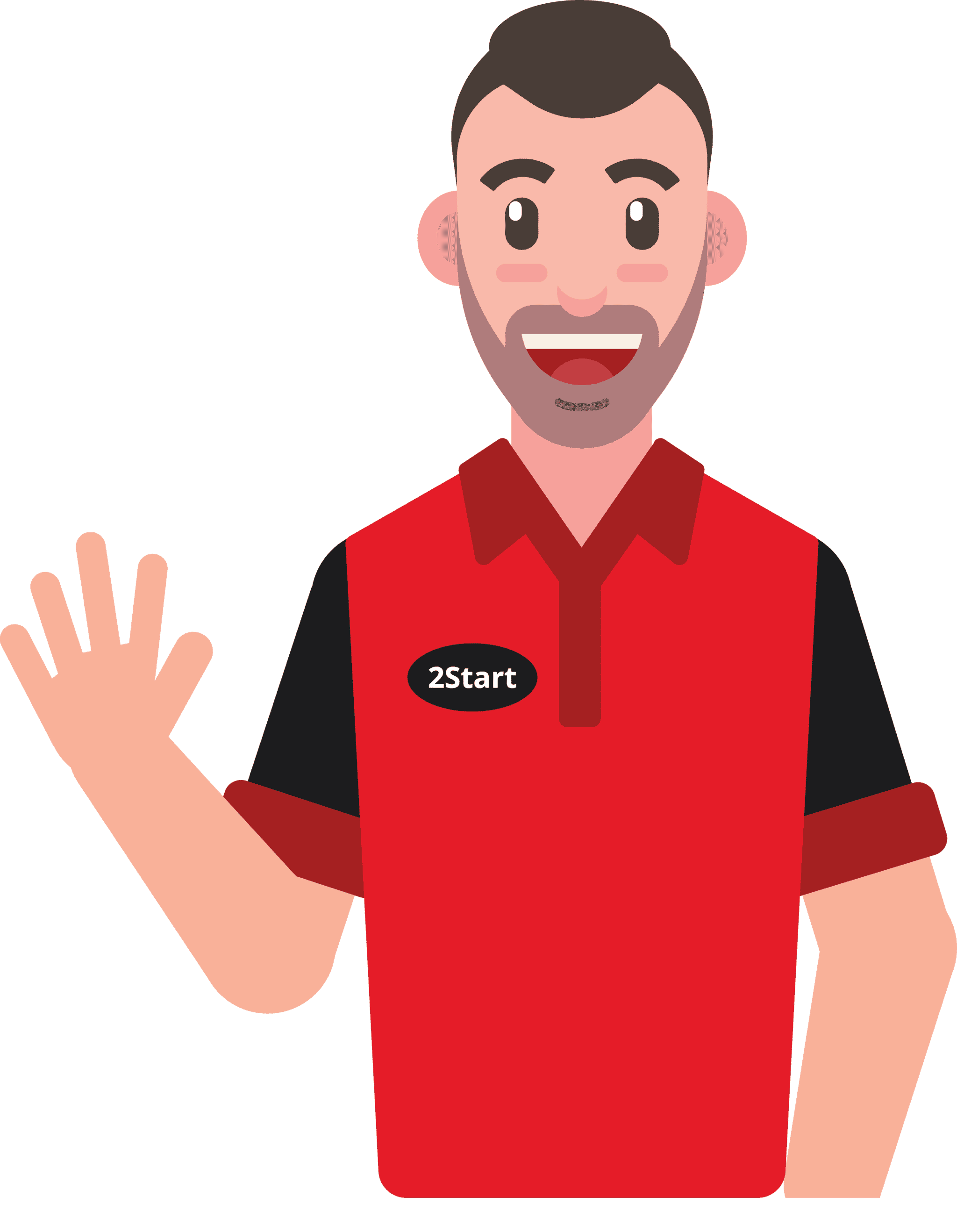Have you decided that you want to work in the logistics sector? Could this be a first-time career path, or a career change? No matter what it is, 2 Start can help you get the confidence to take the leap in 2024!
Logistics is a core part of supply chain management. From working in a warehouse as a forklift operator, handling and packaging goods, to driving a Category C1, C or C+E Heavy Goods Vehicle (HGV).
But the whole industry can seem overwhelming to begin with. Deciding what sector you wish to work in, where to start, and what challenges you may face.
Look no further than our 6 steps to working in the logistics sector. These stages will help you build your confidence, find the right training, and lead you on your journey to success.
Step 1- Choose the Course That Appeals to You
This may go without saying, but the training you decide to partake in matters. You wouldn’t want to complete a full comprehensive course for a sector that you don’t enjoy, or don’t want to work in.
Luckily, there is an array of paths you can choose, which all require different skillsets, yet all work together as a cohesive package in the industry.
A great example of this is the carriage of dangerous goods by road (ADR).
When completing ADR training, the primary course you must complete is ADR core. This covers the general knowledge that you would need when transporting dangerous goods by road. However, there is a vast range of courses revolving around ADR that you can complete, each have different responsibilities attached to them.
Take ADR Packages training. This course type will teach you how to ensure the safe and secure transport of packaged dangerous goods (this is also depending on the class of dangerous good you train for (as there are 9 classes of dangerous goods). This means that you could work as someone who completes the safe and correct packaging and transportation of dangerous goods.
ADR tanks training is also another direction. You can train how to safely transport flammable liquids in tanker trucks, such as petroleum tankers. Alternatively, you can also learn about the importance regarding the transportation of gases, bio hazards acids etc. and transporting them.
These examples prove that there are no limitations as to what avenue you can follow in the logistics industry. You must find what category and course type suits your interest, and even you previous training.
Once you choose the area you want to train in, the next step is to find a reputable & accredited provider who can meet your requirements. This is where 2 Start can help!
Step 2- Find the Right Training Provider For You
Finding the training provider that is right for you can make or break the success of how your training goes. This is because there are many requirements you will have prior to your training that you must explain to the provider.
Also, you need to find an instructor/trainer who can meet your expectations.

When finding a training provider to complete your training, make sure you check for the following to help you get the correct accredited training:
- Is the course you are looking to book accredited by a reputable body?
For example, is the provider’s Lorry Loader Training accredited by the Association of Lorry Loader Manufacturers and Importers, also known as ALLMI. Training courses which are accredited by an awarding body are typically nationally recognised, and ensure your course meets an industry recognised minimum standard. - Are their training locations accessible for you and your training requirements? This is imperative when it comes to your course completion. The location of your provider must be easily accessible for you to get to.
- Are the vehicles, operator equipment and facilities up to date and in good working order?
In order to get the most out of your training, using up to date and well-maintained equipment will help you train efficiently. You wouldn’t want to train in a vehicle that is needing repair or maintenance.
Although, it could be hard to determine which training provider is for you, seeing consistent, positive reviews, and recognition of instructors helps reinforce a good training provider and their reputable services.
This rule doesn’t necessarily stop at training too, this goes in hand when looking for a job in logistics. You want to work somewhere that is compliant with regulations, keeps you in check with your role, and has necessary procedures in place.
If you spot any “irregular” or incorrect practices in a training provider, it is always best to steer clear of them.
Step 3- Ensure You Meet The Training Requirements
You may need to provide forms or documentation to meet the training requirements of the training provider and/or course.
Taking Forklift training as an example, 2 Start provide Novice, Experienced operator, Refresher and Combined training courses. In the instance that you are looking to book a refresher Counterbalance Forklift course, if you do not have the accredited Forklift certificate which says you completed the Novice forklift training (this certificate will also show an expiration date for your forklift licence, typically 5 years) you will not be able to complete this type of training. This also includes the face that the certification must be for that forklift truck in question.
With providers such as 2 Start, we aim to ensure that the course you are booking is the right training for you, and you are booking the correct course without additional modules which you do not require. Our course advisors collect all information needed, so you don’t overpay or complete unnecessary modules.
Other instances include where you may have already met some requirements for a training course you are planning to complete. When booking Category C HGV Driver Training, you may not need to complete a full course (for example, including theory tests, driver CPC etc). This can make your training cheaper, shorter and helps you focus your time on the requirements you need to fulfil.
Always make sure that before you begin a course, you:
- Meet the requirements intended
- Know what training you have already completed (if applicable- this will include any additional forms and certifications you need to supply.)
- Give the training provider as much information as possible revolving around the training you want to complete
These are the primary points to consider and ensure you meet the training requirements with your chosen training provider!
Step 4- Know What Is Included in Your Course
There is nothing worse than booking a course, and not knowing what it entails.
Before starting your training, it is always best to ask as many questions as possible with your training advisor.
If you understand how the layout of your training will progress, the times you will be training, and having a structure to your course, this will help you feel in control and prepared. This subsequently will make you feel more confident and in the know of what you need to learn, practice and implement.
2 Start strives to assure that you have all the necessary information needed. This is so you can feel assured and at ease before you begin your intended training course.
It is vital that you are prepared and have a complete awareness of what you will be doing, and how the structure of your training will be.
There is nothing more disconcerting when you don’t know what will be happening throughout the duration of your course.
Once you are aware of what your course will include, you will then begin your training!

Step 5-Prepare for Any Tests
Your training will typically have a theory based and/or a practical based assessment. This will determine whether you have retained the knowledge that has been given to you over the period of your training.
For courses to become a PASMA and IPAF operator, these assessments will be on the day of your course. If you are completing A full Transport Manager Road Haulage training package, you will complete both a multiple-choice and case study examination, but not before you complete your classroom learning with one of our experienced instructors.
This is where taking notes, obtaining resources and asking the instructor questions is a necessity.
The more you prepare, the more confident you will be in your tests, and the more likely you will pass. Your instructor has an influence as to whether they will put you forward for your test. If they don’t think you have had enough training, they will pull your tests.
Step 6- Keep Training Up to Date!
You have completed the training, passed the relevant tests, well done! You are now qualified in your new line of work and have found the job of your dreams.
Now that you are in the role you intended, and you have completed your initial training. What’s next?
Just because you have completed your core training doesn’t mean you stop learning. You will need to keep up to date with changed, so that you are aware of any recent or new updates to the regulations and rules that have been implemented.
For example, as a professional HGV driver, once you have completed all your training and passed all your tests, you will still need to complete 35 hours of periodic certificate of professional competence (CPC) training every 5 years if you want to continue driving for hire or reward.
Refreshing your training and keeping up to date with all regulatory changes will help you stay confident and compliant in your new job role. It may even help you keep co-workers up to date, as this is good practice.
Your 6 Steps Concluded
So now, you should have all the knowledge you need from our tips to help you with your training journey. Hopefully, you have been able to implement these steps to help you with your logistics training journey.
Step 2 could be swift if you book your course with 2 Start! A reputable provider, with six depots across the South Coast, we can provide you with a comprehensive training course to fit your requirements, so you can train with ease!
If you still have any questions, or would like to discuss your options and make a booking, speak to our advisors on 02392 123 555.



Leave a Reply